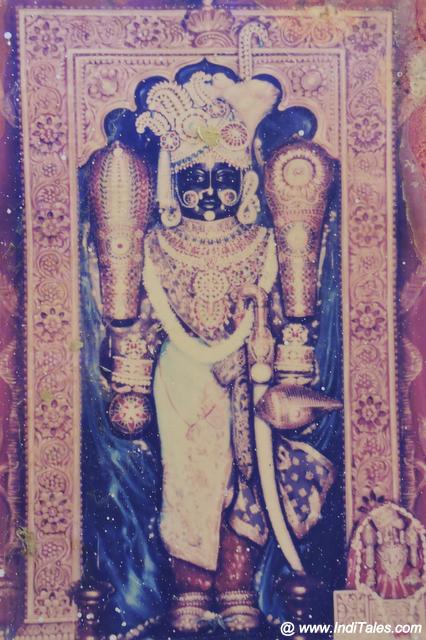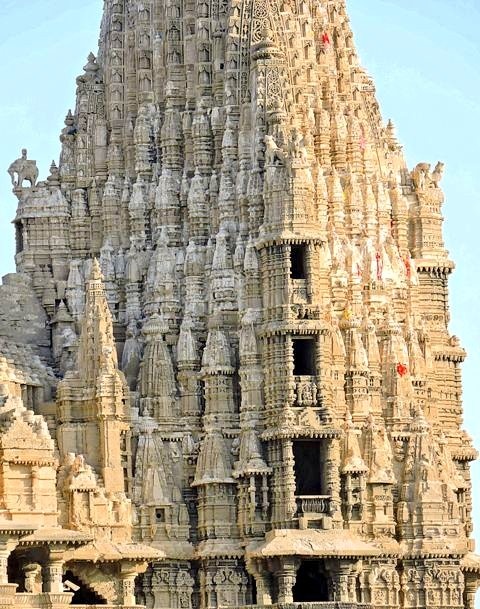The Lost City of Dwaraka
The discovery of the legendary city of Dwaraka which is said to have been founded by Sri Krishna, is an important landmark in the validation of historical relevance of Mahabharata. It has set at rest the doubts expressed by historians about the historicity of Mahabharata and the very existence of Dwaraka city. It has greatly narrowed the gap of Indian history by establishing the continuity of the Indian civilization from the Vedic age to the present day.
The discovery has also shed welcome light on second urbanization in the so-called 'Dark age', on the resuscitation of dharma, on the resumption of maritime trade, and use of Sanskrit language and modified Indus script. Incidentally, scientific data useful for a study of sea level changes and effects of marine environment on metals and wood over long periods has also been generated by underwater exploration. All this was possible because of the dedicated and daring efforts of marine archaeologists, scientists and technicians of the Marine Archaeology Centre of the National Institute of Oceanography.
Dwarka Exploration
Dwaraka is a coastal town in Jamnagar district of Gujarat. Traditionally, modern Dwaraka is identified with Dvaraka, mentioned in the Mahabharata as Krishna's city. Dwaraka was a port, and some scholars have identified it with the island of Barka mentioned in the Periplus of Erythrean Sea.
Ancient Dwaraka sank in sea and hence is an important archaeological site. The first clear historical record of the lost city is dated 574 A.D. and occurs in the Palitana Plates of Samanta Simhaditya. This inscription refers to Dwaraka as the capital of the western coast of Saurashtra and still more important, states that Sri Krishna lived here.
Heart of Dwarkadhish temple, Bet Dwarka is the “मूर्ति” of Sri Krishna that is believed to be built by Rukmini 5244 years ago after Sri Krishna left for his heavenly abode.
The first archaeological excavations at Dwaraka were done by the Deccan College, Pune and the Department of Archaeology, Government of Gujarat, in 1963 under the direction of H.D. Sankalia. It revealed artefacts many centuries old. The Marine Archaeological Unit (MAU) of the Archaeological Survey of India (ASI) conducted a second round of excavations in 1979 under the supervision of Dr S. R. Rao (one of the most respected archaeologists of India). An emeritus scientist at the marine archaeology unit of the National Institute of Oceanography, Rao has excavated a large number of Harappan sites including the port city of Lothal in Gujarat.
He found a distinct pottery known as lustrous red ware, which could be more than 3,000 years old. Based on the results of these excavations, the search for the sunken city in the Arabian Sea began in 1981. Scientists and archaeologists have continually worked on the site for 20 years. The project for underwater exploration was sanctioned in 1984, directly by the then Prime Minister for three years. Excavation under the sea is a hard and strenuous task. The sea offers too much resistance.
Location: Dwarka, Gujarat
Rebuilt in: 16th century
Dedicated to: Lord Krishna
Significance: One of the four pilgrimages of the Hindus
How to reach: One can easily reach Dwarkadhish Temple by taking regular Buses or by hiring taxis from anywhere in Gujarat
Dwarkadhish Temple is one of the four major pilgrimages of the Hindus. Located at Dwarka in Gujarat, the temple is connected by regular buses from various towns and cities in Gujarat. The nearest airport is located at Jamnagar that lies at a distance of 146 kms from Dwarka. The city of Dwarka is regarded as the 'Gateway to Moksha (Salvation)'.
In the main shrine, the central altar embraces the idol of Lord Dwarkadheesh. The image is presented in the form of four-armed Vishnu (Lord Krishna is the incarnation of Lord Vishnu) known as Trivikrama. Apart from this main idol, there are idols of Baldevaji (Balrama), Pradyumna and Aniruddha (grandsons of Lord Krishna) too.
There is a small shrine dedicated to Kuseswara Mahadeva (Shiva) also. Besides these, there are shrines dedicated to Devaki (mother of Lord Krishna), Veni-madhava (Lord Vishnu), Radhika, Jambuvati, Satyabhama, Lakshmi, Saraswati and Lakshmi-Narayan in the temple complex. In the temple, worship or puja is conducted by Aboti Brahmins (a particular caste of Brahmins, who have been performing pooja for centuries). Every day, Arti is performed at regular intervals and 'abhishek' (bathing ceremony) is done. The Lord is decked in new clothes, jewels and flowers. Janmashtami is the major festival that is celebrated at Dwarkadhish Temple. At the time of festival, the entire temple is festooned with lights. Every year, the temple witness millions of devotees and pilgrims, who come to seek salvation, with the blessings of the Lord.
Legend behind the Idol
There is a legend behind the idol of Lord Dwarkadhish in the temple. Badana, an old devotee, used to come daily from Dakor to Dwarka, in order to have a glimpse of the Lord Dwarkadhish. The Lord was really appeased with her and one day, he went along with Badana to Dakor, in the form of idol. The priests at Dwarka temple got angry at Badana, who took the idol according to them. The enraged priests chased Badana to get back the idol. Badana convinced the priests to leave the idol instead of gold.
The priests agreed upon the condition and to their surprise, the idol happened to be as light as one nose-ring. This miracle was done by the Lord himself, as he knew Badana had only a nose-ring to offer. However, the Lord didn't disappoint the priests and said that they would find a replica on a particular day. The priests could not resist their inquisitiveness and excavated the recommended site quite early.
They found one yet to grow idol that is presently enshrined at Dwarka.
History
Around 5000 years ago, Dwarka is believed to have been built by Lord Krishna himself. As per the 'Harivansh' (an appendix to the Mahabharata), Dwarka was positioned on the bank of Gomati River. This holy city is said to have been the abode of Lord Krishna, for more or less 100 years, during his lifetime. Dwarka is assumed to have been immersed in the sea, when the Lord returned to his divine world. In the early eighties, archeological department revealed that the entire coast of western India sank by nearly 40 feet around 1500 B.C.
The present temple is expected not to be older than the Mughal period. The inscriptions on the pillars date back to the 16th century. Necessarily, the ancient temple had been there, but it was possibly destroyed by Mohmud Begada in 1473 AD. In 1473 CE famous poet, scholar & philosopher Maulana Muhammed Samarkandi who was in service of Bahamani Sultnat of deccan was on a voyage to Hormuz. Near Dwarka-Okha his ship was looted by Okha pirates. They caught poet's family women & put Maulana Samarkandi with his 2 sons on seashore. In 1473 CE scholar & philosopher Maulana Samarkandi went Junagadh & complained Gujarat Sultan Mahmud Begada against Okha pirates & requested to save his family women from the captivity of Dwarka-Okha pirates. In 1473 CE Gujarat Sultan Mahmud Begada decided to invade Dwarka-Okha region to punish its Vadhel Rajput ruler Bhimji and pirates of Okha.
King Bhimji Vadhel ancestor are Aj Rathore from Rajasthan who won Dwarka & founded Okhamanadal state with capital at Arambhada in 1212 AD.His son Veravalji's descendants are Vadhel Rajputs.
On 14-5-1473 Gujarat Sultan Mahmood Begada attacked Dwarka. He looted & ruined Dwarkadhish temple. He broke idol & killed innocent citizens. After destruction of Dwarkadhish temple, Sultan Mahmud Begada attacked Okhamandal capital Arambhada & defeated Vadhel ruler Bhimji. Gujarat Sultan Mahmud Begada sent Okha ruler Bhimji in chains to Ahmedabad where his body was chopped in pieces & hanged on fort gates. Gujarat Sultan Mahmud Begada recovered wealth & freed women of family of Maulana Samarkandi from pirates.Samarkandi thanked Sultan. In 1473 Gujarat Sultan Mahmud Begada annexed Dwarka-Okha state to Gujarat Sultnat.He appointed Farhat-ul-Mulk Tughan as Dwarka administrator after winning Dwarka-Okha capital Arambhada, Sultan Mahmud Begda attacked Bet Shankhodwar & destroyed temples and looted people there. There was deep forest in Dwarka-Okha region. In this forest, Sultan Mahmood army suffered a lot by wild animals & poisonous snakes. Gujarat Sultan Mahmud Begada won Dwarka-Okha state & its capital Arambhada from Vadhel Rajput ruler Bhimji. From 15th century when Okhamandal came under Gujarat Sultnat direct rule many Vagher families adopted Islam & became Muslim Vaghers.
Muslim Vaghers are fishermen & live on coastal areas of Jamnagar & Kutch districts. In Kutch, they live at Gundiyali, Mundra, Luni & Bhadreshwar.
In 1572 Gujarat Sultnat was ended & Gujarat became part of Mughal Empire. Enemy of Mughal & runaway last Gujarat Sultan Muzffar for whom Bhuchar Mori battle was fought was hidden in Barda forest.
Muzffar fled to Arambhada-Dwarka in shelter of Vadhel King Shiv Rana whose grandfather Bhimji was killed by Muzffar's great grandfather Mahmud Begda brutally. In 1592 Arambhada-Dwarka Vadhel Rajput ruler Shiv Rana shipped Gujarat last Sultan Muzffarshah to Kuch but Kutch Jadeja ruler Rao Bharmalji refused to give him shelter & handed over Gujarat last Sultan Muzffarshah to Mughal authority. Kutch was a subsidiary state of Gujarat Sultanate. It became a subsidiary state of Mughal power.Bharmalji tried twice to become independent state. After suffering setbacks twice, he agreed to supremacy of Mughal.
Majestic and mesmerizing Dwarkadhish temple, also known as the Jagat Shreeomani Mandir built in solanki Rajput Architecture style by Raja Jagat Singh.
One similar built in same era also known as Jagat Shiromani Temple, Loc - Amer, Jaipur, Rajasthan, Deity- Lord Vishnu, Shri Krishna & Mira bai
Built by:- Jagat Shiromani Mandir was built by Maharani Kanakwati, wife of Maharaja Mansingh I, in the memory of her son Raja Jagat Singh. The construction work of this Mandir started in 1599 AD and the Mandir was completed in 1608 AD.
Architecture
Those who say nothing is perfect
have not seen the engineering of
Ancient Hindu Temples !!
There is a music in the silence of
these carvings...
There is a beauty in antiquity of
these architectures...
JUST FEEL IT AND LIVE IT...........!!
The majestic five-storied structure of Dwarkadhish Temple stands high on the confluence of Gomati River and Arabian Sea. Built with the support of 72 pillars, Dwarkadhish Mandir presents a sight to behold. Elevated to the height of 78.3 meters, the spire of temple dominates the skyline of Dwarka. An eighty-four foot long multicolored flag, adorned with the symbols of the sun and moon, waves from the dome of temple. It is said that originally the temple was built over the 'Hari-Griha' (Lord Krishna's residential place) by Vajranabha, the grandson of Lord Krishna. Dating back to 2500 years, Jagat Mandir (Nija Mandir) makes the sanctum sanctorum of Dwarkadheesh Temple.
View of Lord Dwarkadhish Temple
This colorful sketch was made in 1830 by the British architect William Purser. This is a 191 year old sketch describing the Dwarka temple.
Photo: british library
It comprises a soaring tower and a hall of audience. The audience hall is comprised of both, ancient and existing sculptures. The temple can be entered by two doorways.
The main doorway (north entrance) is known as "Moksha Dwara" (Door to Salvation), whereas the southern doorway is called as "Swarga Dwara" (Gate to Heaven). The outer side of this doorway has 56 steps that take to the Gomati River.
















No comments:
Post a Comment